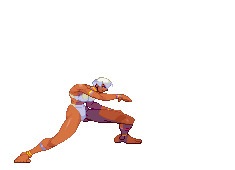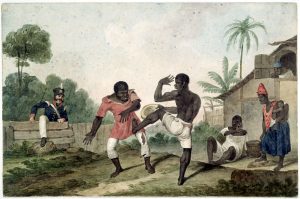A Capoeira é Vida
Fall 2016 the MMA school I was vigorously training at introduced a once-a-week capoeira classes from a local school. It had been almost 10 years since I last attempted this style with friends in Center City. As it so happened I would ginga before all my classes to warm up anyway so this news excited my on many fronts. In just under a year due to overall low turnout the class ended, but it did hook a few people on a regular basis with some of us going to the school nearby in Solebury Township.
For some time I had trained at both locations; usually a few times a month in capoeira and 2x / week MMA. This allowed me to earn my green chord (equivalent to yellow belt in most other martial arts) but if I wanted to continue I needed to make a decision: either go all in for capoeira or stay in MMA and pursue my black belt; I was brown belt at the time and would require another 1.5 years to earn red and then junior black (some call it ‘high red’).
Fast forward to January 2018 and I decided to full time train in capoeira. I had my reasons to not continue MMA despite already investing almost two years by that point. In the end my heart fell capoeira. As I’ve told others, MMA is my wife and capoeira is my mistress.
So, WHAT IS capoeira? There are numerous other places that answer this question, both in history and style. I think a better question is WHY capoeira? Watch this video below my first batizado and see how one graduates to the next level (pool toss is optional).
First, it is an extremely alien style of play from the traditional eastern styles I’ve trained in (Shotokan karate, Bagua kung fu, Tae Kwon Do, Muay Thai). I have spent most of my adult life doing martial arts and consider myself fairly adept at adapting to each one, but you attack and defend in very linear fashion: left or right, duck or jump with slight variations. Even in MMA you learn to defend from eight possible positions using our arms only. Capoeira employs countless angles of attack anywhere from hook sweeping the heel to smacking the opponent’s head with the top of your foot (au batido). Feints, fakes, and misdirection are at the heart of capoeira (look up malandragem for a deeper explanation). Agility, mobility, and dexterity are superior to one’s ability to punch or block.

Elena was my first exposure to capoeira in 1997. Thank you, Capcom!
This is the heart of what intrigues me. I am advanced in traditional arts. I am only average at capoeira. All of my linear brute strength is worthless. On top of that, having to constantly move (ginga), do cartwheels (au), and evade (esquiva) instead of absorbing or redirecting an attack is something new to my 40 years on this planet. Constant movement is a necessity. I can punch my way through wood all day and axe kick like a boss, but it took me almost eight months to do a handstand that lasted from than 1 second. I am learning everything from the ground up as if learning to walk for the first time.
Second, capoeira is not just about learning moves and memorizing combinations but also about becoming familiar with Brazilian Portuguese. I have a basic functional understanding of Spanish so has both helped and hurt me in learning. The similarities are to my benefit (cheese = queso / quejo) except when they aren’t (red = rojo / vermelho), and my complete lack of French has failed to prepare to drop some consonants. I find it an absolute joy in learning new languages, and the more you train in capoeira the more you learn by osmosis. Early on it helps to understand and translate the moves you are doing. Later on you have to learn traditional songs and sing along the refrains with others during rodas. When you really get advanced you must lead in song WHILE playing instruments (that’s a whole separate discussion).
This is a component missing from all the other styles I’ve learned: spiritual fulfilment. You sing songs that have been around for nearly 100 years. In a way you pay respect to those who came before you. Especially when everyone is singing and playing instruments in a cadence and rhythm that gets everyone nearly entranced it is a wonderful experience. You sing as one. This may not be for everybody but it fills my pursuit of language, and by extension, the culture behind the language.
Third, its tragic history. Capoeira is/was a way for the slaves brought over to Brazil via middle passage to keep their religious traditions, music, and to defend themselves once they escaped and lived in the mountains. Slave owners in general, and Brazil in particular, didn’t take well to this and banned it until the early 1930’s. It is a rich tapestry full of mythical heroes, deities, honors for the original modern practitioners (Mestres Bimbe and Pastinha, props!). The history is more about capoeira itself and encompasses a world of Afro-Brazilian culture and heritage that I am only beginning to absorb. My family genetics also reach back to Togo and Benin in Africa, which also fuels my desire to understand more of where my ancestors came from. This doesn’t mean any of my ancestors knew, or practiced, capoeira but it’s geographically very close.

Share Your Thoughts